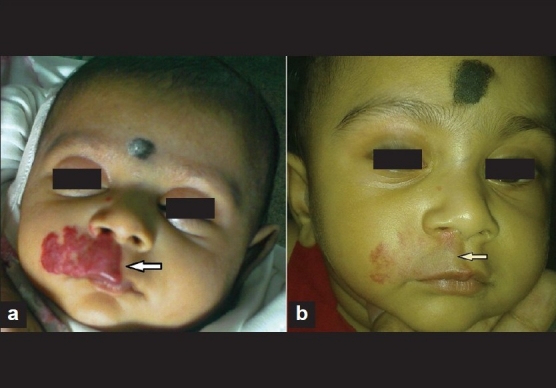Sir,
Hemangiomas of infancy are common, benign, self-limiting malformations, but a significant percent of these lesions are associated with substantial morbidity and cosmetic disfigurement in infancy and childhood.[1] Current treatment options for problematic hemangiomas include systemic or intralesional corticosteroids, chemotherapeutic agents (vincristine, alfa-interferon), laser, surgery or a combination of these therapies. Unfortunately, each treatment option has limited therapeutic benefit, with its own side-effect and risks. Few case reports have been published where hemangiomas regress rapidly when treated with propranolol at a dose of 2 mg/kg/day.[2,3]
Propranolol is a nonselective beta-blocker. Its vasoconstrictive property results in reduction in color and size of the hemangioma. Its primary effect, however, appears to be alteration in the progression of angiogenesis in the hemangioma, by decrease in expression of bFGF and VEGF. In addition, propranolol may promote involution of hemangiomas by triggering apoptosis in endothelial cells.[2]
We have performed this prospective study to explore the impact of propranolol on hemangiomas at our center. A total of 40 patients from 3 weeks to 12 months of age with 21 girls and 19 boys were taken in this study. The study period was from February 2010 to July 2011. Detailed clinical examination with history of previous treatment with steroid or other medication was taken. Contraindications for propranolol (e.g., bronchial asthma, hypoglycemia, gastroesophageal reflux, etc.) were recorded and such children were excluded from the study.
An oral dose of 2 mg/kg/day divided into two to three doses was given to each child.[2] Serial photographs were taken at 3–4 weeks intervals during the course of their therapy to record clinical response. The doses were adjusted as the child grows by taking regular body weight of the child. Propranolol was weaned at the end of treatment by reducing the dose to one-half for 1–2 weeks, and then stopped.
Ten of the 40 patients (25%) had complete resolution with no residual disease. Average time taken was 4 months for complete resolution in these cases. Twenty-nine patients (72.5%) showed progressive reduction in size and color of their hemangiomas [Figure 1]. These patients were considered to be partial responders and are on further propranolol therapy. Only one patient (2.5%) had persistent hemangioma growth despite propranolol therapy for 4 months, and was termed nonresponder. In this study, it is also observed that lesions that respond to therapy earlier show complete resolution earlier. There were no report of any side-effects during the study.
Figure 1.

(a) Photograph at onset of treatment. (b) Four months posttreatment photograph showing almost complete response
Based on the successful results of our study and few other case reports, propranolol appears to be a valuable and effective treatment option for hemangiomas at therapeutic doses (2 mg/kg/day), and it may revolutionize the treatment of hemangiomas.
REFERENCES
- 1.Kilcline C, Frieden IJ. Infantile hemangiomas: How common are they? A systematic review of the medical literature. Pediatr Dermatol. 2008;25:168–73. doi: 10.1111/j.1525-1470.2008.00626.x. [DOI] [PubMed] [Google Scholar]
- 2.Leaute-Labreze C, Dumas de la Roque E, Hubiche T, Boralevi F, Thambo JB, Taieb A. Propranolol for severe hemangiomas of infancy. N Engl J Med. 2008;358:2649–51. doi: 10.1056/NEJMc0708819. [DOI] [PubMed] [Google Scholar]
- 3.Buckmiller L, Dyamenahalli U, Richter GT. Propranolol for airway hemangiomas: Case report of novel treatment. Laryngoscope. 2009;119:2051–4. doi: 10.1002/lary.20633. [DOI] [PubMed] [Google Scholar]


